六年级上册英语知识点汇总
六年级上册英语知识点归纳

often经常 sometimes 有时候 never 从来不二、习惯语搭配:by bike/bus/plane/subway/train/ship/taxi/ferry骑自行车/乘公共汽车/飞机/地铁/火车/船/出租汽车/渡轮take the No.57 bus乘57路公 on foot步行slow down慢下来pay attention to注意 traffic lights 交通信号灯 look right向右看cross the road横穿马路 get off下车 at home在家 traffic rules交通规则 get to到达 get on 上车 be far from…表示离某地远三、惯用表达式:Wait!等一等! Hooray太好了!I see. 我明白了。
Go at a green light 绿灯行Stop at a red light 红灯停 Wait at a yellow light 黄灯等四、公式化句型:1、如何询问对方的出行方式:How do you come(to)+地点?你(们)怎么来···的?2、如何用must表示必须做某事:某人+must+动词原形(+其它). ···必须···。
3、告诫别人不要做某事的句型:Don’t +动词原形(+其它). .不要/别···。
五、例句:How do you go to school? 你怎么去上学?Usually I go to school on foot. Sometimes I go by bus.通常我步行去上学。
有时候骑自行车去。
How can I get to Zhongshan Park ? 我怎么到达中山公园?You can go by the No. 15 bus. 你可以坐15路公共汽车去。
完整版)人教版六年级英语上册知识点汇总总结提纲
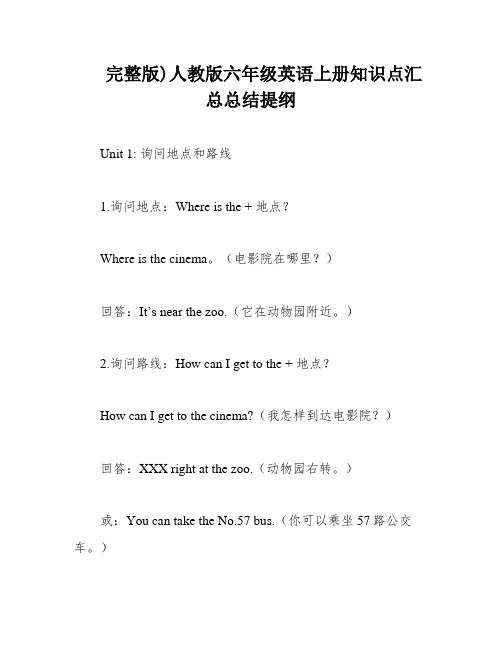
完整版)人教版六年级英语上册知识点汇总总结提纲Unit 1: 询问地点和路线1.询问地点:Where is the + 地点?Where is the cinema。
(电影院在哪里?)回答:It’s near the zoo.(它在动物园附近。
)2.询问路线:How can I get to the + 地点?How can I get to the cinema?(我怎样到达电影院?)回答:XXX right at the zoo.(动物园右转。
)或:You can take the No.57 bus.(你可以乘坐57路公交车。
)Unit 2: 交通方式1.询问某人怎样去某地:How do某人go(come) to + 地点?How do you go to school?(你怎么去学校?)回答:I go to school on foot.(我走路去学校。
)2.规定某人必须做某事:某人 + must + 动词原形XXX.(骑自行车的人必须戴头盔。
)I must pay n to the traffic XXX.(我必须注意交通信号灯。
)Unit 3: 打算做某事某人 + be going to + do(动词原形)She is going to see a film.(她打算去看电影。
)My uncle is planningXXX to go to the supermarket。
In this unit。
there are several types of ns that we can use to XXX。
For example。
we can ask "What are you going to do (+time or place)?" or "When are you going (+place)?" to get an XXX may include phrases such as "I am going to the cinema tomorrow" or "They are going to Nanjing next week."Similarly。
人教版六年级上册英语知识点汇总
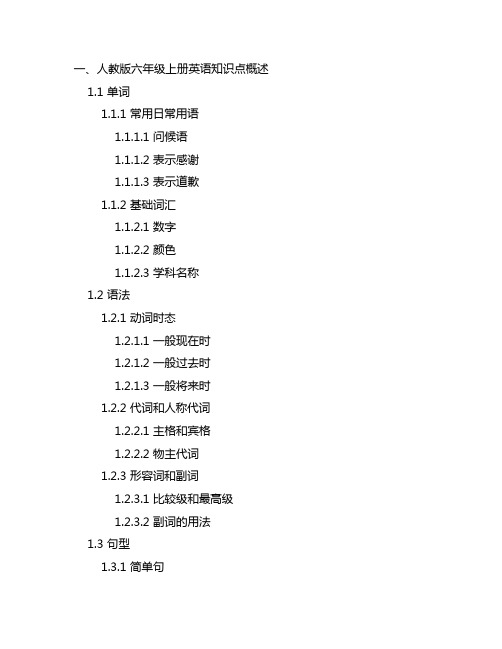
一、人教版六年级上册英语知识点概述1.1 单词1.1.1 常用日常用语1.1.1.1 问候语1.1.1.2 表示感谢1.1.1.3 表示道歉1.1.2 基础词汇1.1.2.1 数字1.1.2.2 颜色1.1.2.3 学科名称1.2 语法1.2.1 动词时态1.2.1.1 一般现在时1.2.1.2 一般过去时1.2.1.3 一般将来时1.2.2 代词和人称代词1.2.2.1 主格和宾格1.2.2.2 物主代词1.2.3 形容词和副词1.2.3.1 比较级和最高级1.2.3.2 副词的用法1.3 句型1.3.1 简单句1.3.1.1 肯定句1.3.1.2 否定句1.3.1.3 疑问句1.3.2 复合句1.3.2.1 并列句1.3.2.2 定语从句1.3.2.3 状语从句二、人教版六年级上册英语知识点详解2.1 单词2.1.1 常用日常用语2.1.1.1 问候语问候语是指在英语日常交际中用于打招呼和示好的常用词汇,包括Hello、Hi、Good morning、Good afternoon等等。
2.1.1.2 表示感谢表示感谢的常用词汇有Thank you、Thanks a lot、Thank you very much等,用于表达对别人的帮助或礼物表示感激之情。
2.1.1.3 表示道歉表示道歉的词汇包括I'm sorry、Excuse me、Pardon等,在日常生活中,用于向别人道歉或请求对方让步的场合。
2.1.2 基础词汇2.1.2.1 数字数字是英语基础词汇的重要部分,包括基本的数字表达方式和计量单位,如one、two、three等,以及hundred、thousand等。
2.1.2.2 颜色颜色是描述事物外观的重要词汇,在日常交流中也经常用到,包括red、blue、yellow等常见颜色词汇。
2.1.2.3 学科名称学科名称涉及到人们日常生活和学习工作的方方面面,包括mathematics、music、art等,是学习英语时必须掌握的词汇。
小学六年级上册英语知识点归纳总结
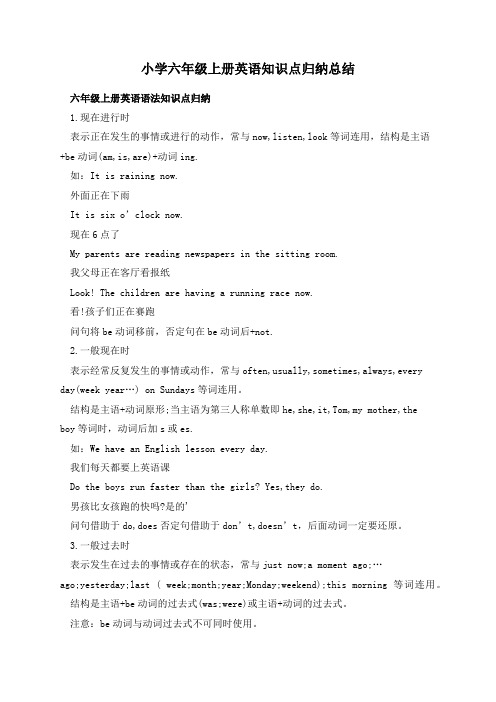
小学六年级上册英语知识点归纳总结六年级上册英语语法知识点归纳1.现在进行时表示正在发生的事情或进行的动作,常与now,listen,look等词连用,结构是主语+be动词(am,is,are)+动词ing.如:It is raining now.外面正在下雨It is six o’clock now.现在6点了My parents are reading newspapers in the sitting room.我父母正在客厅看报纸Look! The children are having a running race now.看!孩子们正在赛跑问句将be动词移前,否定句在be动词后+not.2.一般现在时表示经常反复发生的事情或动作,常与often,usually,sometimes,always,every day(week year…) on Sundays等词连用。
结构是主语+动词原形;当主语为第三人称单数即he,she,it,Tom,my mother,theboy等词时,动词后加s或es.如:We have an English lesson every day.我们每天都要上英语课Do the boys run faster than the girls? Yes,they do.男孩比女孩跑的快吗?是的'问句借助于do,does否定句借助于don’t,doesn’t,后面动词一定要还原。
3.一般过去时表示发生在过去的事情或存在的状态,常与just now;a moment ago;…ago;yesterday;last ( week;month;year;Monday;weekend);this morning等词连用。
结构是主语+be动词的过去式(was;were)或主语+动词的过去式。
注意:be动词与动词过去式不可同时使用。
如:My earphones were on the ground just now.我的耳机刚刚还在呢。
六年级英语上册知识点总汇

六年级英语上册知识点总汇一、介词与介词短语1. 常见介词介词是连接名词、代词或动词与其宾语之间关系的词语。
六年级上册中常见的介词有:in、on、at、to、from、for、with等。
2. 介词短语的用法介词短语由介词和其宾语构成,常用来表示时间、地点、原因、目的等。
例如:in the morning(在早晨)、at school(在学校)、from Monday to Friday(从星期一到星期五)等。
二、时态与语态1. 一般现在时一般现在时表示经常性、习惯性或普遍性的动作或状态。
句子结构为主语 + 动词原形,例如:She likes swimming.(她喜欢游泳。
)2. 一般过去时一般过去时表示过去发生的动作或状态。
句子结构为主语 + 动词过去式,例如:They visited the museum last week.(他们上周参观了博物馆。
)3. 一般将来时一般将来时表示将要发生的动作或状态。
句子结构为主语 + will + 动词原形,例如:I will go to the park tomorrow.(我明天将去公园。
)4. 被动语态被动语态表示主语是动作的承受者。
句子结构为主语 + be + 过去分词,例如:The book was written by Mark Twain.(这本书是马克·吐温写的。
)三、名词与数词1. 可数名词与不可数名词可数名词指可以计数的名词,可以有单数和复数形式;不可数名词则不能计数,只有单数形式。
例如:a pen(一支笔,可数名词)、water(水,不可数名词)等。
2. 名词所有格名词所有格表示所属关系,通常在名词后加's构成。
例如:Tom's book(汤姆的书)。
3. 基数词与序数词基数词表示数量或顺序,例如:one、two、three等;序数词表示顺序,例如:first、second、third等。
四、形容词与副词1. 形容词的比较级和最高级形容词的比较级表示两个事物之间的比较,结构为形容词 + er + than,例如:taller than(比...更高);最高级表示三个或三个以上事物中的最高级,结构为the + 形容词的最高级,例如:the tallest(最高的)。
六年级英语上册各单元知识点归类总结

六年级英语上册各单元知识总结Unit1 How can I get there?一、词汇:science museum科学博物馆post office 邮局bookstore书店cinema电影院hospital医院crossing 十字路口turn left左转turn right右转go straight直行二、描述某地点所处位置的短语near在…..附近next to与…..相邻beside在…..旁边in front of 在……前面behind在…..后面between 在…..之间三、问路句型where is + 地点名词?(......地方在哪里?)It’s + 方位介词+ 地点名词.(它在......)如:Where is the cinema?电影院在哪儿?It’s next to the hospital.它在医院旁边.四、问路常见句子1.Where is the cinema, please? 请问电影院在哪儿?It’s next to the hospital. 它在医院的旁边.It’s in front of the school. 它在学校的前面.It’s behind the park . 它在公园的后面It’s near the zoo. 它在动物园的附近.It’s far from here. 它离这儿很远.2. Excuse me, is there a cinema near here ? 请问这附近有电影院吗?Yes, there is. /No,there isn’t.有./没有。
3. How can I/we get there? 我(们)该怎样到达那儿?Turn left at the bookstore. 到书店左转。
4. How can I get to the hospital? 我该怎样到达医院呢?Take the No.57 bus. 乘坐第57路公汽。
六年级上册英语必考知识点有哪些
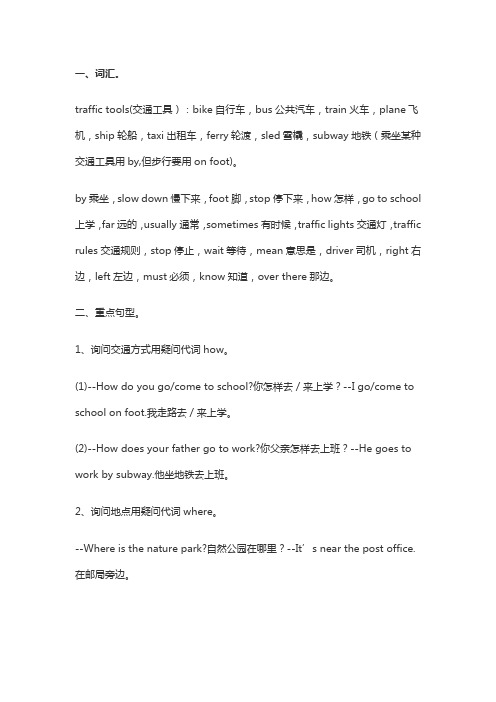
一、词汇。
traffic tools(交通工具):bike自行车,bus公共汽车,train火车,plane飞机,ship轮船,taxi出租车,ferry轮渡,sled雪橇,subway地铁(乘坐某种交通工具用by,但步行要用on foot)。
by乘坐,slow down慢下来,foot脚,stop停下来,how怎样,go to school 上学,far远的,usually通常,sometimes有时候,traffic lights交通灯,traffic rules交通规则,stop停止,wait等待,mean意思是,driver司机,right右边,left左边,must必须,know知道,over there那边。
二、重点句型。
1、询问交通方式用疑问代词how。
(1)--How do you go/come to school?你怎样去/来上学?--I go/come to school on foot.我走路去/来上学。
(2)--How does your father go to work?你父亲怎样去上班?--He goes to work by subway.他坐地铁去上班。
2、询问地点用疑问代词where。
--Where is the nature park?自然公园在哪里?--It’s near the post office.在邮局旁边。
--Where are the teachers?老师们在哪里?--They are in the teacher’s office.他们在办公室里。
3、问路。
-- How can I get to the Fuxing hospital?我怎么去福星医院?--Take the No.57 bus over there.在那边乘坐57路公交车。
4、交通规则。
Slow down and stop at a yellow light. Stop and wait at a red light. Go at a green light. Don’t go at a red light.别闯红灯。
小学六年级英语上册知识点总结
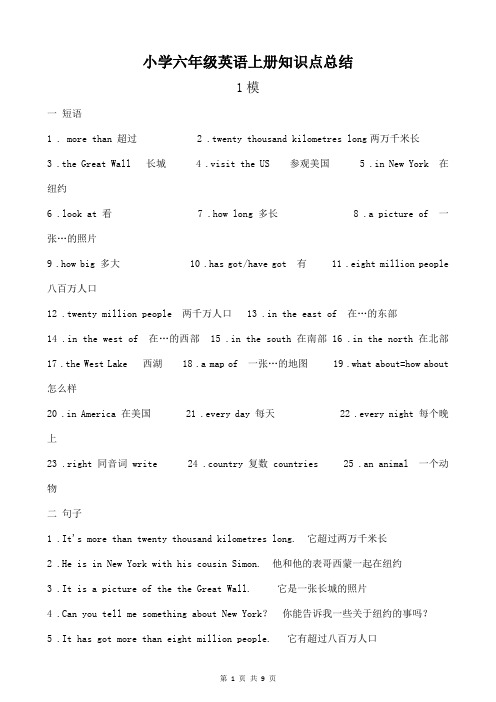
小学六年级英语上册知识点总结1模一短语1 . more than 超过2 .twenty thousand kilometres long两万千米长3 .the Great Wall 长城4 .visit the US 参观美国5 .in New York 在纽约6 .look at 看7 .how long 多长8 .a picture of 一张…的照片9 .how big 多大 10 .has got/have got 有 11 .eight million people 八百万人口12 .twenty million people 两千万人口 13 .in the east of 在…的东部14 .in the west of 在…的西部 15 .in the south 在南部16 .in the north 在北部17 .the West Lake 西湖 18 .a map of 一张…的地图 19 .what about=how about 怎么样20 .in America 在美国 21 .every day 每天 22 .every night 每个晚上23 .right 同音词 write 24 .country 复数 countries 25 .an animal 一个动物二句子1 .It's more than twenty thousand kilometres long. 它超过两万千米长2 .He is in New York with his cousin Simon. 他和他的表哥西蒙一起在纽约3 .It is a picture of the the Great Wall. 它是一张长城的照片4 .Can you tell me something about New York?你能告诉我一些关于纽约的事吗?5 .It has got more than eight million people. 它有超过八百万人口6 .Beijing has got about twenty million people. 北京大约有两千万人口7 .It is in the west. 它是在西部8 .It's in the east of China. 它是在中国的东部9 .What a big map of the US!多么大的一张美国地图啊!2 模一短语1 .Chinese dancing 中国的舞蹈2 .any 用于否定句或一般疑问句中3 .in China 在中国4 .send an email 发送一封电子邮件5 .send sb sth=send sth to sb 给某人发送或邮寄某物6 .want sth 想要某物7 .want to do sth 想要做某事 8 .let's=let us 后加动词原形让我们9 .there 对应词 here 10 .the Changjiang River 长江11 .the Huangshan Mountain 黄山 12 .in the street 在大街上二句子1 .There is Chinese dancing. 有中国的舞蹈2 .There's a Chinatown in New York. 在纽约有一个唐人街3 .I'm sending an email to my family in China.我正在给我在中国的家人发送一个电子邮件4 .Do you want to go to Chinatown?你想要去唐人街吗?5 .Let's go to Chinatown. 让我们去唐人街吧6 .There are lots of beautiful lakes in China. 在中国有许多漂亮的湖7 .This is the famous Changjiang River. 这是著名的长江3模一词组1 .collect stamps 收集邮票2 .all of these stamps 所有的这些邮票3 .another Chinese stamp 另一张中国邮票4 .collect dolls 收集玩具娃娃6 .picture books 图画书7 .fly a kite=fly kites 放风筝8 .Chinese kites 中国的风筝9 .dragon kites 龙风筝 10 .ride a bike=ride bikes 骑自行车11 .play a game= play games 玩游戏 12 .collect toy cars 收集玩具汽车二句子1 .Collecting stamps is my hobby. 收集邮票是我的业余爱好2 .These are stamps from Canada. 这些是来自于加拿大的邮票3 .Have you got any stamps from China?你有一些来自于中国的邮票吗?4 .These stamps are from my letter. 这些邮票是来自于我的信5 .Is there a letter for me?有一封给我的信吗?6 .What's your hobby?你的爱好是什么?7 .Flying kites is my hobby. 放风筝是我的爱好8 .Taking pictures is my hobby. 拍照是我的爱好9 .Do you collect stamps?你收集邮票吗?4模一短语1 .my favourite festival 我最喜欢的节日2 .on Thanksgiving Day 在感恩节3 .on Flag Day 在国旗制定纪念日4 .fly the flag 升国旗5 .sing songs 唱国歌6 . after Thanksgiving dinner 感恩晚餐之后7 .American festival 美国的节目8 .have a special meal 吃一顿特殊的饭9 .on TV 在电视上10 .the Spring Festival 春节 11.eat moon cakes 吃月饼12 .at the Mid-Autumn Festival 在中秋节 13 .at the Dragon Boat Festival 在端午节14 .see the dragon boat race 看龙舟比赛 15 .hang lanterns 挂灯笼16 .do dragon dances 舞龙 17 .hang 过去式 hung二句子1 .Thanksgiving is my favourite festival. 感恩节是我最喜欢的节日2 .On Thanksgiving Day we say “thank you”for our food ,family and friend.在感恩节,我们对我们的食物,家人,朋友说谢谢你。
- 1、下载文档前请自行甄别文档内容的完整性,平台不提供额外的编辑、内容补充、找答案等附加服务。
- 2、"仅部分预览"的文档,不可在线预览部分如存在完整性等问题,可反馈申请退款(可完整预览的文档不适用该条件!)。
- 3、如文档侵犯您的权益,请联系客服反馈,我们会尽快为您处理(人工客服工作时间:9:00-18:30)。
六年级上册英语知识点汇总Unit 1 How can I get there?知识点重点单词和短语Science科学, museum博物馆, post office, bookstore, cinema, hospital ,tasty, buy, London Eye伦敦银, stomach胃 ,crossing十字路口, turn left,turn right,go straight=walk straight直走.next to紧挨着/与。
相邻, far from(离。
远),near在。
附近 ,behind(在。
后面) , in front of(在。
前面) , between…and…(在。
和。
之间)按要求写单词:hot(反义词)cold , cool(反义词)warm,too(同音词)to/two can not(缩写)can’t right(反义词)left/wrong buy(同音词)by/byesea(同音词)see first(基数词)one four(序数词)fourthdid (原形)do /does three(序数词)third give(过去式)gave重点句型分析1.Where is the museum shop?此问句是由特殊疑问词where 引导的一个特殊疑问句, where意为“在哪里,到哪里”,用来询问地点,放在句子的开头。
询问“某人或某物在哪里”的基本句型是:“ Where +is/are+ 主语?”, where is 后接名词或代词的单数形式,where are 后接名词或代词的复数形式。
表示地点的词:museum博物馆, postoffice邮局, bookstore书店, cinema电影院, hospital医院 restaurant餐馆bank银行 bus stop公交车站lake湖 library图书馆zoo动物园 school学校 park公园 garden花园 hotel旅馆2.It’s near the door. X k B 1 . c o m此句中near是表示位置的介词,意为“旁边,附近”,其同义句是:It’s next to the door.它在门的旁边。
表示位置的短语:next to the bookstore挨着书店 near the hospital在医院附近 near the post office在邮局附近over there 在那边on Dongfang Street在东方大街上 in front of theschool在学校前面3. How can we get there?此句用来询问“怎样去某地”,后面直接跟地点。
回答时,可以用“ Turnleft, turn right, go straight.”等句来回答。
同义句:1.Can you tell me the way to+地点?2.Where is the +地点?3.Which is the way to +地点4. Turn left at the bookstore. Then turn right at the hospital.此句是指路的句型。
常用到的句型有:turn left, 向左转turn right, 向右转go straight直着走。
同时表示在某处的介词用at.5.Is the Thames far from here? No, it isn’t.此句是个be动词开头的一般疑问句,其回答要用Yes或No. 句中的far from 意为“离……远”。
反义词组为next to.六年级上册Unit 2 Ways to go to school直击考点重点单词和短语on foot步行, by bus =take a bus 乘公交车 by plane,乘飞机 by taxi 乘出租车by ship乘船 by subway 乘地铁by train乘火车 by bike骑自行车by ferry乘轮渡Hooray!好极了slow down 慢下来, stop 停 wait等 pay attention to注意 cross the road横穿马路 traffic light通信号灯at home在家 missed(miss的过去式)想念 different,不同chopsticks,筷子(复数)cross穿过 look right向右看 same 相同的door 门look at朝。
看 play with和。
一起玩新- 课 -标- 第 -一 - 网按要求写单词:go (反义词)come foot(复数)feet child(复数)childrenearly(反义词)late good(反义词)bad坏 take带走(反义词)bring拿来slow(反义词)quick/fast go (过去式)went do(过去式) diddo(第三人称单数) does go(第三人称单数) goessame 相同的(反义词)different不同的 miss(过去式) missedwrong 错误(反义词)right正确 can(否定形式)can’t重点句型分析1.How do you come to school?你(们)怎么来学校的?此问句是由特殊疑问词how引导的特殊疑问句,用于询问对方的出行方式。
回答时要根据具体情况作答。
X k B 1 . c o mually, I come on foot.=Usually, I walk.通常情况下,我步行来。
此句是对出行方式的回答句。
其中usually意为“通常”,表示频率很大,on foot意为“步行”。
一般用by表示出行方式。
By后面一定要直接加交通工具的单数形式,只有“小脚丫”foot与on 搭配,“步行”用on foot表示。
3. I must pay attention to the traffic lights.我必须注意交通信号灯。
Must是情态动词,意为“必须”后面跟动词原形。
4. Don’t go at the red light!别闯红灯!此句是Don’t开头的否定祈使句, don’t后面跟动词原形。
意为“不要做某事”。
Eg. Don’t smoke.不要吸烟。
/禁止吸烟。
Don’t take photos.禁止拍照。
5 We must look right before crossing the road.我们在横穿马路前必须看看右边。
此句中must是情态动词,意为“必须”后面跟动词原形,在此句中before 是一个介词,而介词后面跟动词-ing形式。
6. There is no door on the bus.公共汽车上没有门。
此句是there be句型的单数句, be动词要根据后面名词的单复数形式来决定,名词为单数或不可数名词就用there is, 名词为复数就用there are.此句中no door意为“没有门”,表示单数含义,因此要用there is开头。
小学六年级Unit 3 My weekend plan知识点小结直击考点重点单词和短语visit拜访 film电影 see a film看电影 trip旅游take a trip去旅游supermarket, 超市evening晚上,傍晚 tonight在今晚tomorrow明天next week下周dictionary 字典comic 滑稽的comic book连环画册word book单词本postcard明信片learn 学习teach教disturb打扰 without没有pool池子 jump in跳进 remember记住 lesson 课space太空 travel(尤指长途)旅游 half一半 price 价格moon 月亮 make a snowman 堆雪人share sth(事)with sb(人)和某人分享某物 lots of= a lot of 许多按要求写单词look for (同义词) find leaf (复数) leaves picture (复数) picturessee (同义词) watch/look film (同义词) movie buy (反义词) sellam /is /are (原形) be is /am (复数)are this (反义词) thatgoing (原形) go swim (现在进行时)swimming can(否定形式) can’ttoo(同音词) two /to clothe(复数)clothes ice-skate(现在进行时)ice-skatingautumn(同义词) fall autumn(反义词)spring teach (反义词) learn 重点句型分析1.---What are you going to do tomorrow?---I’m going to have an art lesson.此句是个一般将来时态的特殊疑问句。
用了be going to 结构。
“be going to +动词原形”构成一般将来时态,表示计划、安排将要做的事或根据目前推测将要发生的动作,意为“打算,将要”。
X k B 1 . c o meg: I’m going to make a snowman.我打算去堆雪人。
We’re going fishing.我们打算去钓鱼。
2.We are going to draw some pictures in Renmin Park.此句是be going to 结构的肯定句式。
基本结构为:主语+ be going to +动词原形+表示将来的时间。
Some一些,用于肯定句中,后接可数名词的复数形式或不可数名词,而在疑问句或否定中表示一些要用any。
3---Where are you going?---We’re going to the cinema.此句是where 引导的一般将来时态的特殊疑问句, where意为“哪里”,它是对地点提问的特殊疑问词,因此回答时要回答一个具体的地点。
4---When are you going?---Next Monday.此句中when意为“什么时候,何时”,它引导的疑问句用来对年、月、日等时间进行提问。
如:---When do you go to school in the morning?---At 8:00.5---How can you learn to swim without going to a pool?此句是由how 引导的特殊疑问句,询问别人做事的方式、方法。
句中的can 意为“能够”,是情态动词,后面跟动词原形。
